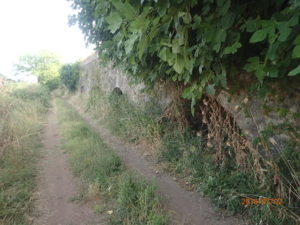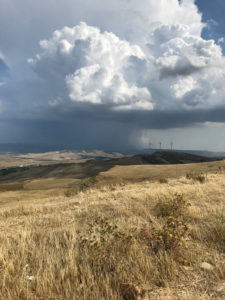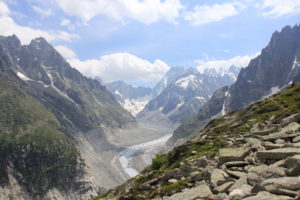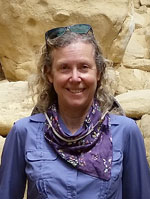Postcards from the Mediterranean: Groundwater, Glaciers, and Geoparks
Article 15 and the Human Right to Benefit from Science
One of the enduring themes for AAG Annual Meetings is Geography, Science, and Human Rights. We will continue to incorporate this nexus of human and physical geography, and GIScience, into the 2019 AAG annual meeting as a major theme. Understanding and teaching the right to benefit from science is more important now than ever. We inhabit a world of political uncertainty but growing scientific certainty, a time where the U.S. Endangered Species Act is currently under attack, and a planet where coastal villages are threatened by icebergs from Glaciers breaking up due to global warming, at the same time that communities ranging from Athens Greece to Yosemite and Redding, California are ravaged by fires stoked by record summer heat.
Article 15 of the International Covenant on Economic, Social and Cultural Rights requires states to: “recognize the right of everyone to enjoy the benefits of scientific progress and its applications; conserve, develop, and diffuse science; respect the freedom indispensable for scientific research, and recognize the benefits of international contacts and co-operation in the scientific field.”
These principles embed scientific benefits and freedom within economic, social, and cultural rights. Only 4 of 163 nations have not ratified Article 15 thus far, and the U.S. is one of the 4. The more we can educate our students and future leaders about this fundamental right, the stronger our communities and healthier our environment, and the future, can become. In addition to arming ourselves with knowledge, taking geographical action can shape our future. Contributions by geographers include mapping and documenting social and environmental changes through space and time; explaining their origins, processes and human interactions; and proposing potential solutions to stem the damage to our planet and its future. Several overlapping fields of environmental history, historical ecology, and biogeography presents us with the long view of human interactions with a changing planet, and insight into societal response and responsibility in global environmental change. We can promote Article 15 by coupling a linked understanding of the enduring benefits of Cultural and Natural Heritage Resources, a natural partnership for human geographers, physical geographers, and GIScientists.
Cultural and Natural Heritage: Aqueducts and Antiquities in Italy

Geoparks and World Heritage sites offer insights into natural wonders and past human environmental interactions and innovations. Ancient Rome drew its waters from the surrounding countryside, including groundwater springs emanating around nearby caldera lakes. Groundwater is the second largest storehouse of fresh water on earth after glacial ice. What links groundwater, glaciers, and geoparks is that all contain ecofacts of the past. The water in a groundwater aquifer or in a glacier may take millennia to cycle through. Field research this July took our team to the headwaters of those ancient Roman springs, and to a little-known link to the modern world: Roman aqueducts still deliver spring water to the modern city of Rome. Under storm drain lids and behind locked gates, springs provide fresh water for millions of people. One of the water managers of those springs told us, however, that the groundwater production is lower this year, as observed in one of the several nearly empty cisterns our team visited in July. Like California, this is a symptom of drier, hotter summers and increasing water demands on the aquifers, overtaking their recharge. Imagine a water delivery system in place since Imperial Rome that now is becoming inadequate. Ancient aqueducts are outdoor museums as well as lifelines for the modern community, and an enduring lesson in hydroengineering. We will continue researching this site as part of the Water Stories section of UT Austin’s Planet Texas 2050 Research project, providing relevance to modern cities and agriculture in increasingly thirsty regions.

About 500 km south of Rome, the Ancient Greek city of Morgantina, a UNESCO World Heritage Geopark in Sicily, provides both modern ecotourism and a window on past societies. Morgantina also drew upon springs and water systems more like qanats than aqueducts for its water supply, as does the contemporary city of Aidone near the ancient city. Though ancient Morgantina’s architectural wonders have persisted, its surrounding Sicilian watersheds are choked with eroded sediment, over 2 meters in a few decades judging by the modern sneaker found embedded in a stream cutbank this summer. Erosion events regularly cover modern highways with sediment, and strip farmland of top soil, frittering away Saharan dust and Etna ash. In the face of the bimodal Mediterranean climate regime of hot and dry summers followed by winter rain and mudslides, too few of Sicily’s modern farmers have incorporated water and soil conservation to save their rationed water, using drip irrigation systems in orchards and vineyards, and contour plowing for dryland grain crops. A modern dam blocks the once free flowing Gornalunga River, forming the reservoir Lago di Ogliastro, to provide water to the region. Abandoned farmhouses dot the landscape, indicating the latest boom and bust cycle on this semi-arid island in the ancient Middle Sea. Urban Aidone, like so many Mediterranean places, experiences water rationing and dwindling cisterns.
Melting Glaciers, Mount Blanc, and Changing Ecosystems

Recent research by NOAA, EPA, and the National Park Service has documented “early spring” affecting ecosystems around the country, especially in the northern continental U.S. For example, Washington, D.C.’s famous cherry blossoms have a long-term trend of peak bloom 5 days earlier over the last 90 years. The timing of leaf emergence and blooms, and cycles of wildlife and pollinators have become out of sync in places due to changing seasonality linked with global warming. Researchers in Rocky Mountains National Park have been following the early spring cycles impacts on Alpine ecosystems and wildlife adaptability, as documented recently by National Public Radio. In addition to supporting the ecosystems of alpine zones, Glacial Ice (in ice caps and mountains) is the largest storehouse of fresh water on Earth. I had the rare opportunity to do alpine zone field work this July with a first-year Geography Ph.D. student in the French Alps, hiking along the snow line and moraines near Mt. Blanc to examine emerging ecosystems and their services in the wake of glacial retreat. Since most glaciers around the world are retreating, there is no shortage of study sites.
Yosemite is Burning
John Muir wrote, “When we try to pick out anything by itself, we find it hitched to everything else in the Universe.” Slope stabilization links to the integrity of mountain geomorphic systems, hydrologic and ecological systems, and to human communities and livelihoods (see: R. Marston, Annals 2008, 98:507-520). In the wake of the current California wildfires, including Muir’s beloved Yosemite, mudslides and more human tragedy will likely follow. As science is a human endeavor hitched to human rights, it is a privilege to share our work, to ensure its broader impacts, and to create an environment in which geographical research may thrive and benefit the world through new knowledge and effective policy.
Another major theme that holds these places together is refugees, and France and Italy have shared in this global phenomenon. In Aidone, migrants are a growing portion of the population, just like the ancient Greek migrants were 2,500 years ago. Whether studying climate refugees, or migrants fleeing conflict, Geographers have so much to contribute to the intersections of environmental justice and human rights.
A Geography meeting featuring that intersection is the 2018 Race, Ethnicity, and Place Conference hosted by Texas State University and the University of Texas at Austin, October 23-26, 2018 in Austin. The REP Conference organizers call for original papers, paper sessions and panel submissions that further scholarship relating to race, ethnicity, and place. The theme of the 2018 REP conference, Engaged Scholarship: Fostering Civil and Human Rights, encourages geographic scholarship related to civil and human rights issues that intersect with race, ethnicity, diversity and/or social/environmental justice. Submissions are due by August 24th.
Finally, be ready to share your Geography at the Annual Meeting of the American Association of Geographers April 3-7, 2019, in Washington, D.C. We look forward to seeing you there!
Please share your ideas with me via email: slbeach [at] austin [dot] utexas [dot] edu
— Sheryl Luzzadder-Beach
President, American Association of Geographers
Professor and Chair, Geography and the Environment, The University of Texas at Austin
DOI: 10.14433/2017.0039

